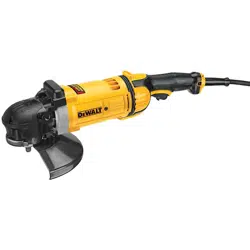Loading ...
Loading ...
Loading ...

English
12
Mounting and Using Wire Brushes
and Wire Wheels
Wire cup brushes or wire wheels screw directly on the
grinder spindle without the use of flanges. Use only wire
brushes or wheels provided with a 5/8"–11 threaded hub.
A Type 27 guard is required when using wire brushes
andwheels.
CAUTION: To reduce the risk of personal injury,
wear work gloves when handling wire brushes
and wheels. They can become sharp.
CAUTION: To reduce the risk of damage to the
tool, wheel or brush must not touch guard when
mounted or while in use. Undetectable damage
could occur to the accessory, causing wires to
fragment from accessory wheel or cup.
Mounting Wire Cup Brushes and Wire
Wheels
1. Thread the wheel on the spindle by hand.
2. Depress spindle lock button and use a wrench on the
hub of the wire wheel or brush to tighten the wheel.
3. To remove the wheel, reverse the above procedure.
NOTICE: To reduce the risk of damage to the tool,
properly seat the wheel hub before turning the tool on.
Using wire Cup Brushes and Wire
Wheels (Fig. P)
Wire wheels and brushes can be used for removing rust,
scale and paint, and for smoothing irregular surfaces.
nOTE: The same precautions should be taken when wire
brushing paint as when sanding paint (refer to Precautions
To Take When Sanding Paint).
1. Allow the tool to reach full speed before touching the
tool to the work surface.
2. Apply minimum pressure to work surface, allowing the
tool to operate at high speed. Material removal rate is
greatest when the tool operates at high speed.
3. Maintain a 5° to 10° angle between the tool and work
surface for wire cup brushes.
5˚–10˚
Fig. P
4. Maintain contact between the edge of the wheel and
the work surface with wire wheels.
5. Continuously move the tool in a forward and back
motion to avoid creating gouges in the work surface.
Allowing the tool to rest on the work surface without
moving, or moving the tool in a circular motion causes
burning and swirling marks on the work surface.
6. Remove the tool from the work surface before turning
the tool off. Allow the tool to stop rotating before
setting it down.
CAUTION: Use extra care when working over an
edge, as a sudden sharp movement of grinder may
beexperienced.
Mounting and Using Flaring Cup
(Type 11) Wheel
Mounting Flaring cup wheel Guard
(Fig. Q)
WARNING: The flaring cup wheel guard is not
included with this tool. Flaring cup wheels require
proper flanges and guards. 4" flaring cup wheel guard
D284934 and 5"– 6" flaring cup wheel guard D284936
are available as accessories and include proper
flange. Failure to use the proper flange and guard can
result in injury resulting from wheel break age and
wheelcontact.
1. Install the guard as shown in Fig.Q.
2. Guard body should be positioned between the
spindle and the operator to provide maximum
operatorprotection.
3. Securely tighten the two clamping screws
21
supplied
with the guard.
Fig. Q
21
Mounting Flaring Cup Wheel (Fig. R)
1. Remove the soft mount
7
.
2. Install the flaring cup wheel backing flange, aligning
the flats on the spindle
22
with the flats on backing
flange
17
.
3. Thread the flaring cup wheel on spindle by hand,
seating wheel against backing flange.
4. Depress the spindle lock button and tighten the wheel
by hand.
5. To remove the wheel, reverse the above procedure.
Fig. R
7
22
17
CAUTION: Failure to properly seat the wheel against
backing flange before turning the tool on may result
in damage to the tool or the wheel.
Loading ...
Loading ...
Loading ...
